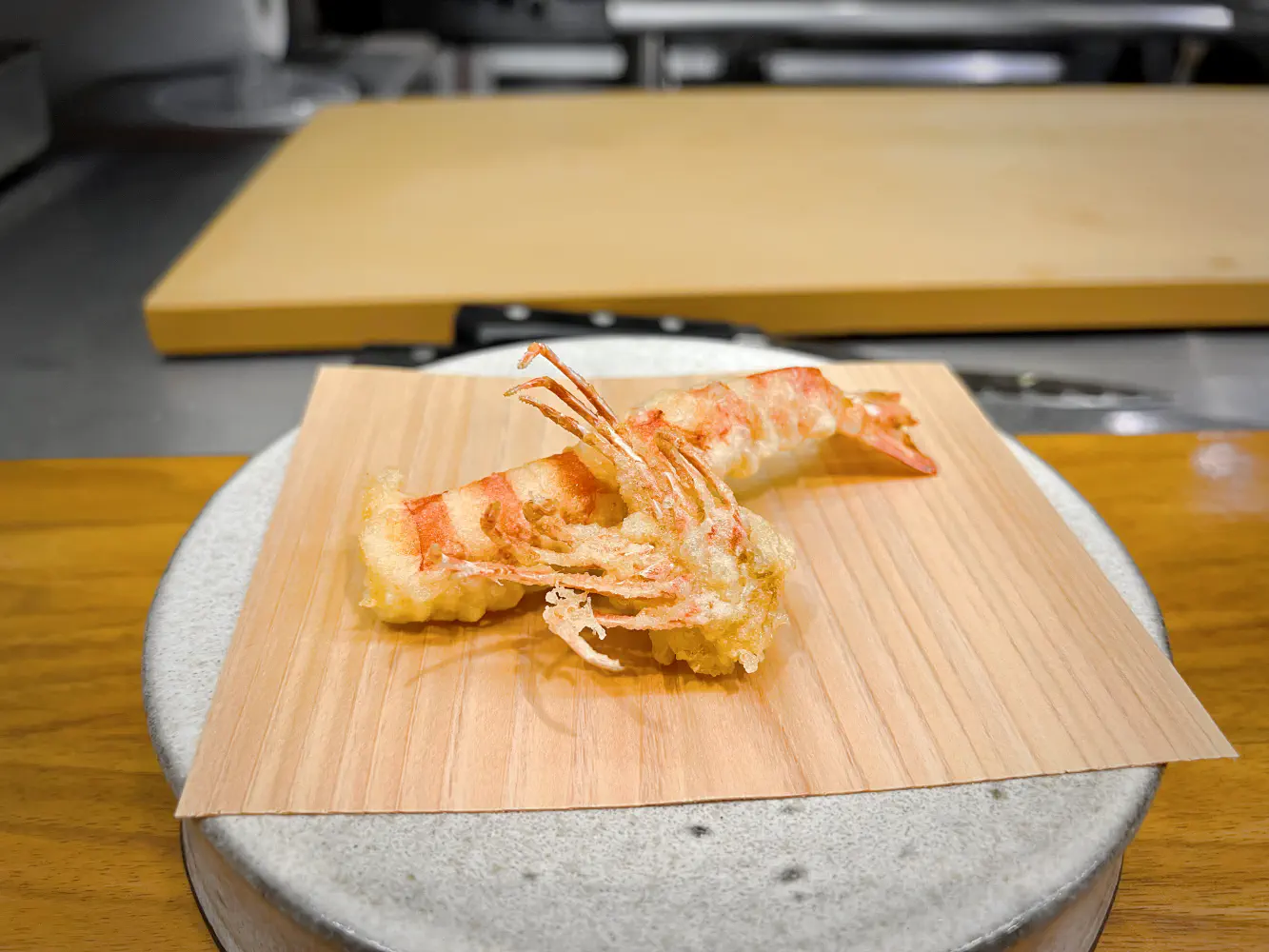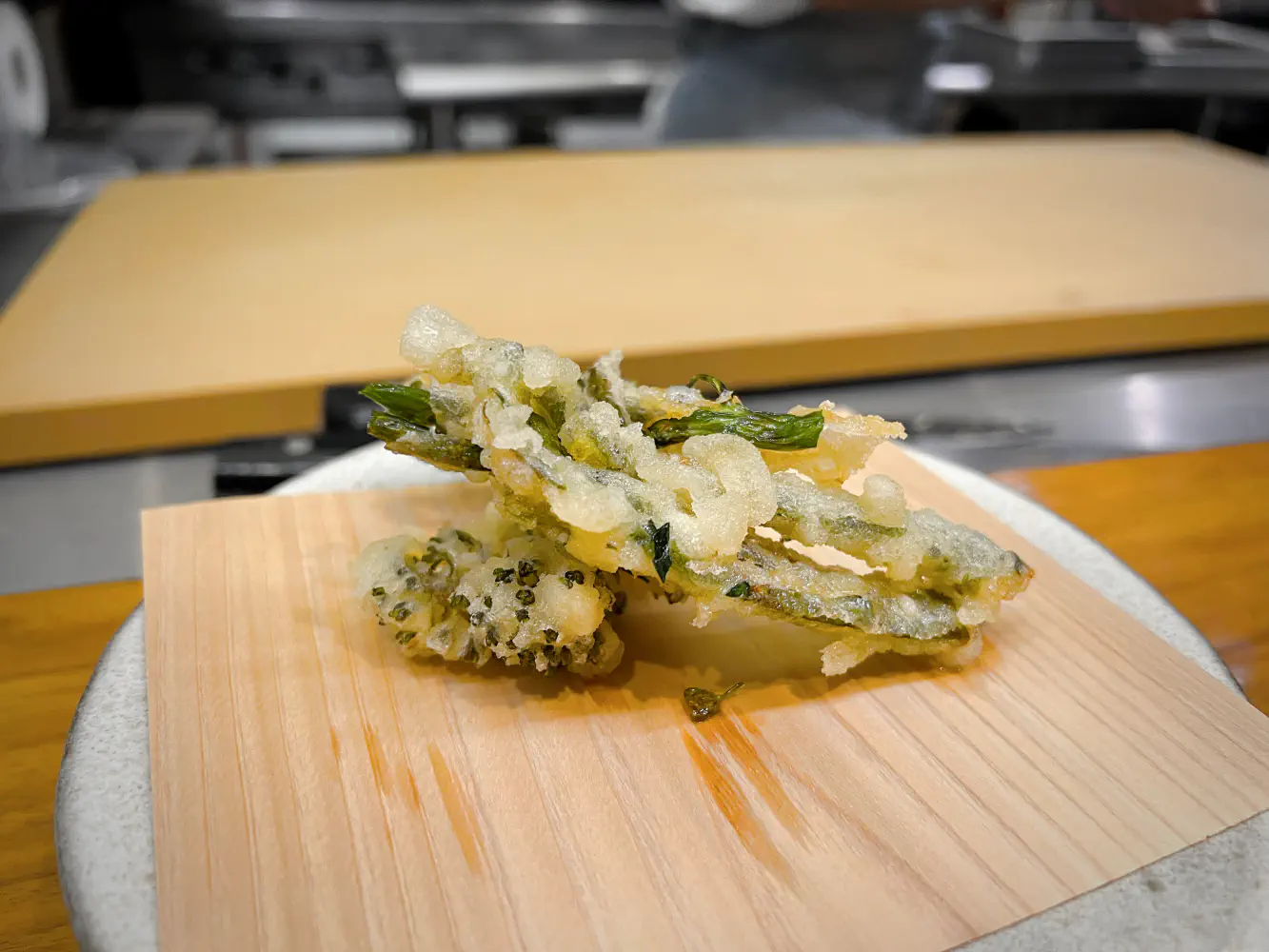Secchu Yokota

Tempura is one of those things in Japanese cuisine that is pretty expensive for what it is, but when you find the right batter with the right ingredients, it’s so good. In Torrance in California, it’s been over a decade since I tried specialized tempura, so I was craving it recently. Unfortunately my partner loathes tempura for some odd reason, so I opted to dine alone when they decided to watch a Broadway show. I was able to successfully book a reservation for 1 via their website (through their email link) the day prior for 5:30 PM.
From their website:
It takes its name from the Japanese term “wayou secchu,” which literally translates to “Japan & west” “compromise/meeting halfway”, and refers to the blending and coming together of Japanese and western ideas and styles. Our offerings reflect owner-Chef Atsushi Yokota’s diverse cultural and culinary background.
At Secchu Yokota, you will find Japanese and western ingredients, flavors and techniques that compliment and play off of each other to offer guests a unique and intimate dining experience.
Ambiance & Service
The restaurant as a whole only seats 6 people total, and they have anywhere from 2-3 sessions per day. There were just 2 people working there: 1 server and 1 chef. The interior looks like a small living room, and it feels like you’re eating inside someone’s home kitchen.
There was very minimal interaction with the chef which was fine since he was super busy and non-stop working. The server introduced each course and was very attentive and friendly. The service was quite engaging and offered suggestions for seasoning for relevant tempura courses.
The price for the tempura omakase was $145 before tax and tip. The total time for dinner was about 2.5 hours which zoomed by.
Food

The Kagua Blanc ($11 - 330ml) was a Belgian style pale ale infused with sansho pepper and yuzu. I vaguely tasted the yuzu and a little spicy at the tip of the tongue. The crispy beer was otherwise very similar to regular Belgian pale ales except less creamy and fairly light.

The first course was a chilled carrot soup with mounted caviar and bonito jelly. In the middle of the carrot soup, lies the bonito jelly. Essentially it has a gelatinous texture with loads of bonito flake flavor. The mounted caviar, which is a type of edible seeds, didn’t have much flavor to me. For those that don’t have the palette for detecting the sweetness of carrots, this course probably would’ve tasted bland. For me though, it was balanced with a hint of sweetness and coolness to counter the hot, humid NYC weather.

For the second course which is the appetizer, they gave us a dip of soy sauce and wasabi oil. I tried the wasabi oil out, and the wasabi flavors were faint.

The appetizer came with the following things:
- Kanpachi (yellowtail) sashimi (bottom left). This came with a daikon radish base, cucumber, and some herbs. They ask you to dip this into the soy sauce wasabi oil. Because the wasabi oil wasn’t very potent, it did add some umami to the soy sauce. The yellowtail itself was very fresh.
- Octopus (bottom right). This came served with ratatouille and mustard seeds. The octopus was small and very chewy. My first thought was that this probably was nothing like Spanish octopus. The ratatouille was concentrated in flavors, so offered a decent yin-yang to the mild flavor of the octopus.
- Soba noodle (top right). This came with duck breast, shiso leaf, soy sauce jelly, and wasabi oil. This was my favorite of all the appetizers here. The duck breast was quite delicious, and they ask you to stir the noodles around. At the bottom of the soba is a small pool of wasabi oil. In the middle lies the soy sauce jelly. Just eating all this together, it was very good.
- Japanese omelette (top left). The egg omelette came with eel, spinach, wheat cake, and a balsamic vinegar dressing. The eel was quite good. The wheat cake was there to provide more of a texture balance to the egg omelette. The spinach was dressed with some vinegar, so it tasted very much like a light salad.
All these appetizers were served either room or slightly colder temperatures. It was very hot and humid outside, and this definitely helped counterbalance the outside air.

Now starts 8 courses of tempura servings. They give you a plate with several seasoning ingredients (clockwise from the lemon):
- a lemon wedge - seeds removed and very juicy
- pickled daikon radish - this was thinly sliced radish soaked in lightly sweetened vinegar.
- wasabi salt - has a slight kick to it with the salty effects but quite flavorful.
- seaweed salt - seems to be similar to Himalayan pink salt, albeit saltier in bulk and with some umami.
- tempura dipping sauce with bonito flakes - very delectable and the bonito flakes added additional profile to the dip.

The rock shrimp came with the head separated as well as the meat pulled out of its shell. The head tasted delicious with the wasabi salt and a little drizzle of lemon. The body had a distinct sweetness to it, despite being fried and being so small. It tasted good with the pink salt and with the tempura dipping sauce.

The broccolini was delicious. The leaves taste very much like if you roast them in the oven with olive oil. They crisp up very nicely.

The pike eel (also known as hamo) actually came with 2 pieces, but I ate one and realized I had forgotten to take a picture. They showed us a picture of what the eel looks like, and it looks vicious with long teeth. Despite being flash fried, the eel meat was fatty and tasty.

The Japanese eggplant was large and had very watery textures. They recommended you take the pieces and squish them in the tempura dipping broth to not only disperse the heat of the eggplant meat but also to absorb the broth. It was surprisingly really good.

The Hokkaido snow crab came with 2 pieces, and they recommended eating it in small pieces with or without salt. The snow crab meat was very sweet and tasty. I enjoyed adding wasabi salt and a little dripping of lemon as well.

The sweet potato didn’t need any seasoning as it was quite sweet on itself.

The shiso leaf came with a huge wad of Hokkaido uni. If you didn’t know, Hokkaido uni is very creamy and very sweet. The shiso flavors were a bit non-existent, but I think it was mainly a vessel to just scoop all that uni.

The Hokkaido scallops were the last tempura course. You can tell it’s slightly raw in the middle, and it was extremely juicy and flavorful. This just needed a little salt with a lemon splash. It was fantastic.

The rice course came with thinly sliced shiso leaf, salted branzino, wasabi oil, seaweed, and some soup.

They pour the broth after they give you the rice dish, and it was pretty amazing. The salted branzino was legitimately salty, so having this broth counter balanced that well. The flavors of everything here made this very light but also perfectly balanced in flavors.

Right before the dessert, they gave some rice tea which has very low caffeine. It’s served hot, so be careful. This was a great night cap for the meal. They also refill it right after you finish the dessert.

The dessert came with coconut vanilla sorbet and crackled rice. On the side there was sticky rice shell with white peach, candied red bean compote, whipped cream, and shiso leaf.
Unfortunately, I totally forgot to take a picture before I ate this dessert. Let me see if I can describe this somewhat. The bowl contained a white coconut vanilla sorbet that resembled a bit like frozen yogurt. In the bottom of it, there were semi hard crispy rice clusters.
The sticky rice shell looked similar to the wafer sandwich from the Kono dessert. It was half opened just like the Kono picture. At the bottom of the shell was a thin layer of physical red bean with compote syrup. Above that was a very dense whipped cream. And finally on top of that was a thick slice of white peach that had a gooey, liquid texture similar to canned peaches. They placed the shiso leaf to lie against this layered tower. You basically take the 2 shells, collapse them, and eat all this as a sandwich.
It was all very tasty and very delicately sweet as expected with meticulous Japanese desserts.
Overall Impression
Secchu Yokota is simply delicious and almost a hidden gem within the East Village area. The tempura is quite balanced and unique, and the ingredients are seasonally fresh. For a tempura omakase, I was pleasantly surprised by the quality and recommend this as an alternative to sushi omakase. Please note for super heavy eaters, you probably won’t feel full. For me, it was the right amount.
Yelp Jabs
However I think there was a bit lack of interaction from the chef since the restaurant is designed with an open kitchen. Usually when you were able to watch the chef making the dishes you would expect some level of interaction.
It seemed to me that the chef was quite busy in preparing the food, and any extensive interaction could have lengthened our meal. I think the server more than made up for that deficit, so I don’t think it’s really needed. Besides, there are people such as myself who could care less about the interaction and would much prefer to be at peace.
It was a little bit on the warmer side as the chef started frying the tempura pieces but it was manageable.
This review was back in 2022, but I wonder if they have changed things. When the chef started frying things, I thought it was fine.
Revisions
- Jul 26, 2023 - Initial revision.